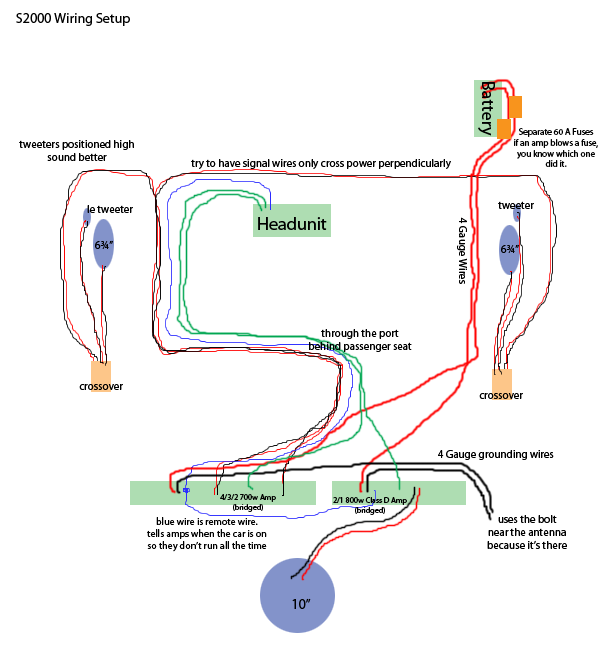Things I Learned from Wiring a Car Stereo
So I just finished installing a car stereo into my car. I wanted to do it myself to learn as much a possible. This post is to share bits of information that were previously buried on message boards, or were myths that car audio shops had previously told me (or debunked for me).
DISCLAIMER: I’m not a professional, any of this could be false, I just want to share what I now know, and believe to be true.
Running power
- The entire chassis is grounded. This is why you remove the black contact first when installing a battery; you don’t want the red contact to brush up against the chassis and cause a short.
- Shorts are bad, because resistance approaches zero, and Voltage=Current*Resistance. Voltage is a constant 12 volts, and all that current gets converted to heat (fire)
- Install fuses as close to the battery as possible. This reduces the risk of a short by accidentally touching the red wire to the chassis.
- Your amp should have fuses on it (e.g. mine each had two 25A fuses). Add up the total amperage, and use a fuse near the battery slightly higher than this (I used a 60A fuse going to each amp).
- Battery power to the amps is DC, while lines going from the amps to the speakers is AC. This is why you need expensive high gauge wire for power, but speaker wire can be relatively thin in comparison.
- It is a half-myth that electricity travels on the surface of the wire. This is only true for AC power, and should be most current travels on the surface, not all; so high thread-count for AC is important and not for DC. It is called the skin effect, and happens because at every point in a cross section of a wire, magnetic flux is inducing back EMF causing resistance, and the center of the wire is subject to highest amount of this. DC has no alternating flux, so this doesn’t happen, and resistance is even across the cross section of the wire. However high threadcount wire can be bent more before breaking, so it’s easier to snake around corners; that’s really the only advantage of it for power wire.
- Avoid cheap alloy wires that are copper-coated. You can tell by looking at the ends of the wires where it is cut; it should be solid copper. Pure copper wire is fairly heavy too. If you get this wire, make sure it has low resistance.
- At high amperages, the resistance of the power wire becomes significant. Calculate amps by watts = amps * volts (where volts is 12). If too much current goes through, too much heat is created which melts the insulation off and the wire touches the chassis which is grounded and causes a short. Since you installed a fuse, it will blow rather than your car catching on fire.
- When grounding the amps, use the same gauge you used for running power. The same amount of current flows through them. Since the chassis is grounded, they can be terminated by bolting these to the chassis. Sand down the area where they’re bolted, because it’s probably painted (to stop rust and corrosion).
Amps and Speakers
- Class D amps are good for subwoofers. They are generally 2/1 channel, which means they have 2 channels, but you can “bridge” the two together to get twice the boost for one channel.
- Ignore the “max” watts of a speaker or amp, and only pay attention to RMS (Root Mean Square), which is essentially the “average” power of a speaker or amp. Don’t buy speakers who don’t list this, unless they are free, which in that case they are probably half of the “rated” power.
- Pair your amp to your speakers; which means get an amp with slightly more average power than the speakers.
- It is better to have underpowered speakers than an underpowered amp. If your volume goes too high the amp will start clipping at peaks and troughs. At these points, pure DC is sent over the line rather than AC. DC creates heat which burns out the coils in your speakers. This is how speakers are usually blown.
- Do not run signal wires parallel to power. If they cross, make it happen perpendicularly. Electrical Induction is a magical thing that you should avoid because it makes phantom buzzing in your music.
Headunits
- This is the thing that goes in the dash, and is usually the flashiest and most superficial of things.
- All Alpine headunits have RCA plugs out that go to the amp. This is not always the case for other makers.
- There is a blue wire in the wiring harness somewhere; this should be run to the “remote” terminal on your amps. It is how the car tells the stereo that the car is on (rather than parked idle); without this your amps would always be on, and always be draining your battery. It’s very low current, so really thin wire will suffice.
Crossovers
- They separate high frequencies and low frequencies.
- These are electrically very simple things. You can build them yourself if you can solder. Don’t spend a lot of money on them.
